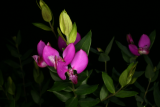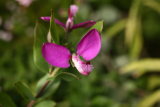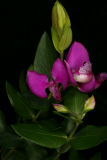Additional notes (click to expand)
Nomenclature
Polygala myrtifolia L. Polygalaceae Cultivar 'Grandiflora'. Myrtle-leaf milkwort. Name Polygala comes from the Greek for 'much milk'. Lyte (1578) calls Birdes Foote Trefoil (with yellow flowers), Polygala of Dioscorides. The accompanying woodcut of Lentilles, Lens, looks like Polygala but not myrtifolia which has shorter, myrtle-like leaves. Parkinson (1640) noted that none of his contemporaries had sorted out what the plant of Dioscorides was, and his are milkweeds, calling them the Greater Milk wort, Polygala major.
Oakeley, Dr. Henry F. (2013). Wellcome Library notes.
link
Other use
Polygala myrtifolia L. Polygalaceae Cultivar 'Grandiflora'. Myrtle-leaf milkwort. Distribution: Europe. Name Polygala comes from the Greek for 'much milk'. Lyte (1578) calls Birdes Foote Trefoil (with yellow flowers), Polygala of Dioscorides. The accompanying woodcut of Lentilles, Lens, looks like Polygala but not myrtifolia which has shorter, myrtle-like leaves. Both Gunther (1959) and Lyte follow Dioscorides in using them for diarrhoea, menorrhagia, and breasts engorged with milk. Parkinson (1640) noted the same uses, but also noted that none of his contemporaries had sorted out what the plant of Dioscorides was, and his are milkweeds, calling them the Greater Milk wort, Polygala major. No modern uses.
Oakeley, Dr. Henry F. (2013). Wellcome Library notes.
link
Geographical distribution
- Africa, Southern Africa, Cape Provinces
- Africa, Southern Africa, Free State
- Africa, Southern Africa, KwaZulu-Natal
Polygala myrtifolia L.
Family: POLYGALACEAEGenus: Polygala
Species: myrtifolia L.
Distribution summary: South Africa
Habit: Shrub
Garden status: Not currently grown
Reason for growing: Medicinal

.JPG)
.JPG)



.JPG)